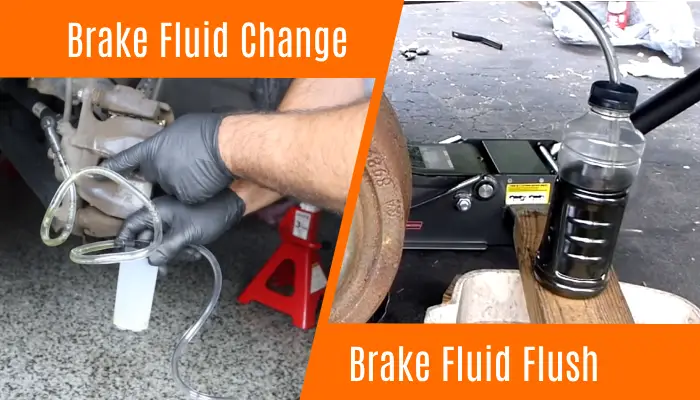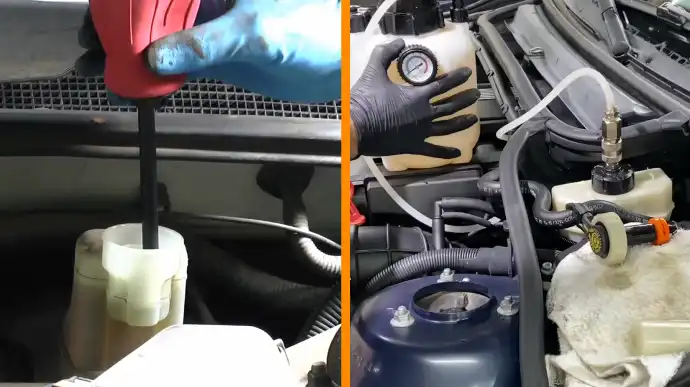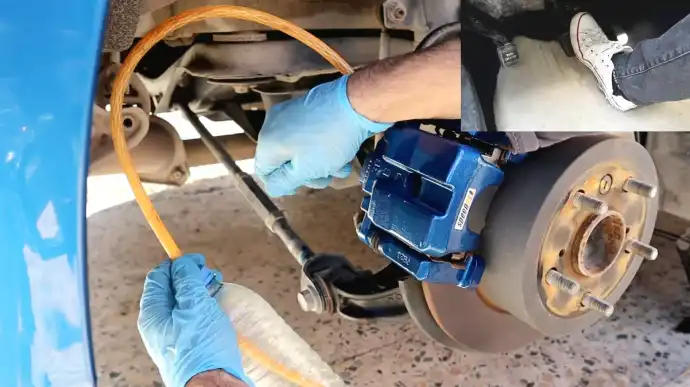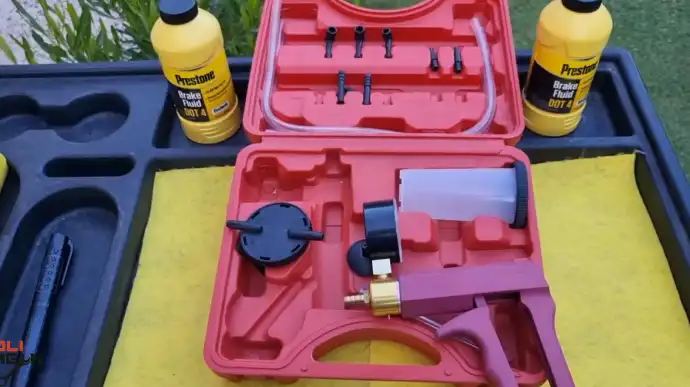Physical Address
304 North Cardinal St.
Dorchester Center, MA 02124
Physical Address
304 North Cardinal St.
Dorchester Center, MA 02124

Braking systems are one of the most essential components of a vehicle. Two procedures often mentioned when maintaining your vehicle’s braking system are brake fluid change and brake flush.
While both these procedures deal with the vehicle’s brake fluid, let me tell you they vary in their procedure, purpose, and frequency of service. Hence, you must understand the difference between these two procedures and decide which one your vehicle needs.
Brake fluid change involves replacing a portion of old fluid, while a flush completely removes and replaces all fluid. A brake flush effectively removes trapped air bubbles, ensuring optimal brake performance and preventing potential brake system issues.
We will discuss the key differences between a brake fluid change and a brake flush based on various factors. So, let’s explore more about it.
Through this article, I’ll discuss the key differences between a brake fluid change and a brake flush based on various factors. So, let’s explore more about it.

I’ve found several key differences when comparing a brake fluid change to a flush on a vehicle.
A brake fluid change involves draining a portion of the old fluid from the brake reservoir and refilling it with new fluid. This process aims to maintain the brake fluid at an acceptable level.
However, a brake flush is a more comprehensive procedure that involves completely replacing the old fluid with new fluid using a pressurized flushing machine. The primary purpose of a brake flush is to remove all the old fluid, including moisture and contaminants, and replace it with clean brake fluid.
A brake fluid change focuses on maintaining the fluid level, it doesn’t address the presence of air bubbles in the hydraulic system. Air bubbles can lead to a spongy brake pedal and decreased braking performance.
In contrast, a brake flush is specifically designed to remove old brake fluid and any air trapped in the brake lines. Flushing the system ensures the hydraulic system is free from air bubbles, allowing optimal brake performance.
Manufacturers typically recommend a brake fluid change or refill every 10,000 to 20,000 miles or every year. This involves filling the old brake fluid with new fluid.
On the other hand, a brake flush is recommended every 30,000 miles or every two years, depending on your driving and braking patterns. The old brake fluid is completely removed and replaced with fresh fluid during a brake flush.
A brake fluid change or refill is typically done as part of routine maintenance and is a preventive measure. It may not be necessary if the brake fluid appears clear and meets the vehicle manufacturer’s recommendations.
Conversely, a brake flush should only be performed for a valid reason, such as experiencing symptoms like a bad noise from the brake pedal, longer stopping distances, or contaminated brake fluid. This service is often suggested unnecessarily and can be costly if not needed.
If you frequently drive in harsh conditions or tow heavy loads, you may need to consider a brake flush rather than just a brake fluid change.
You will need specific tools and equipment for a brake fluid change and a brake flush on your vehicle. Basic tools like a wrench to open the brake fluid reservoir and a container to collect the old fluid are sufficient for a brake fluid change and refill.
However, a brake flush requires specialized equipment to ensure a thorough and effective flush of the brake system. This includes a pressurized flushing machine designed to replace all the old fluid with new fluid.
The pressurized flushing machine is essential for achieving optimal results in flushing the brake system. Without this equipment, removing and replacing all the old fluid with fresh fluid would be challenging.
Regarding the ABS, a brake flush is crucial for maintaining its integrity and performance. Unlike a routine brake fluid change, a brake flush goes beyond replenishing the fluid and focuses on eliminating air bubbles and contaminants that can compromise the ABS.
The ABS relies on hydraulic pressure to function effectively, and any air bubbles in the brake fluid can disrupt this pressure, leading to decreased braking performance. Also, contaminants in the fluid can cause valve blockages or affect the responsiveness of the ABS.
Think about which option will ensure optimal braking efficiency and responsiveness on your vehicle. While a brake fluid change helps maintain the fluid level, it may not significantly improve braking performance or address issues like a spongy brake pedal.
However, a brake flush can noticeably impact the braking performance, particularly if there are existing issues due to air bubbles or contaminants in the system. By removing old contaminated fluid and replacing it with fresh fluid, a brake flush can result in firmer and more responsive brakes.
Performing a brake fluid change as a DIY task is feasible for many vehicle owners with basic tools and knowledge. However, a brake flush typically requires professional expertise and specialized equipment, making it less suitable for DIY tasks.
Auto mechanics are often called upon to perform brake flushes due to the technical nature of the process and the need for precision. They have the necessary skills and equipment to ensure that the brake system is properly flushed and free from any contaminants.
Generally, a brake fluid change and refill is less expensive than a brake flush. This is because a brake fluid change involves replacing only a portion of the brake fluid and doesn’t require specialized equipment.
In contrast, a brake flush is more comprehensive and involves using specialized equipment, making it more expensive. However, it’s important to note that the cost can vary depending on the service provider and the region.
| Feature | Brake Fluid Change | Brake Flush |
| Frequency of Service | Every 10,000 to 20,000 miles or every 2 years | Every 30,000 miles or every 2 years (approximate) |
| Air Removal | Does not address air in brake lines | Removes air bubbles from brake lines |
| Tools and Equipment | Basic tools (wrench, container) | Specialized equipment (pressurized flushing machine) |
| Fluid Replacement | Partial replacement of old fluid | Complete replacement of all old fluid |
| Contaminant Removal | Does not address contaminants in the system | Removes contaminants (moisture, debris) from system |
| ABS System Consideration | May not ensure complete ABS system integrity | Addresses ABS system needs, ensuring optimal function |
| Cost Variation | Generally lower cost | Tends to be more expensive due to specialized equipment |
| Performance Impact | Minimal improvement in braking performance | Can result in noticeable improvement in braking performance |
| Professional vs. DIY | Suitable for DIY with basic tools | Typically requires professional expertise and equipment |

If you notice that your brake pedal feels soft or spongy when you press on it, I assure you your brake fluid may need to be refilled. Also, several signs indicate:
If you experience a soft or spongy brake pedal, it’s time for you to consider a refill or flush of the brake fluid. A soft brake pedal is a common sign that there may be air bubbles or moisture in the brake fluid, which can compromise the efficiency of your braking system.
When air or moisture enters the brake system, it reduces the hydraulic pressure to engage the brakes, resulting in a softer pedal feel. This can be dangerous as it increases the distance it takes for your vehicle to come to a complete stop.
A brake fluid flush can help remove any air or moisture from the system, restoring pedal firmness and ensuring your braking system’s safety.
The ABS dashboard light, also known as the Anti-Lock Braking System light, is designed to alert you to any issues with your ABS system.
When the brake fluid becomes contaminated or deteriorates over time, it can cause the ABS light to illuminate. This indicates that the brake fluid needs attention, either through a refill or a flush.
Ignoring this warning can lead to compromised braking performance and potentially unsafe driving conditions.
Ineffective braking performance can manifest in various ways, such as slowing down or difficulty pressing the brake pedal. These signs indicate that your brake fluid may be compromised and need attention.
Contaminated or deteriorated brake fluid can significantly reduce braking effectiveness, compromising your safety on the road.
Refilling the brake fluid can remove any contaminants or moisture that may have accumulated over time, restoring the fluid’s proper viscosity and ensuring that it can effectively transmit hydraulic pressure to the brake components.
If you notice any strange noises coming from your braking mechanism, it’s essential to promptly address the issue by getting a refill or flush of your brake fluid. These sounds may include grinding or scraping noises, which indicate that the brake pads aren’t properly lubricated.
Burning smells can also be an indication of overheated brake fluid. This can occur when the fluid cannot effectively dissipate heat, leading to excessive friction and heat buildup. A brake fluid flush can help eliminate these issues by removing any contaminants or debris causing strange noises.
You should consider a brake fluid flush to ensure the optimal performance of your vehicle’s brake system. Brake fluid is hydrophobic, which means it absorbs moisture over time. This moisture can lead to various issues in your brake system.
As the brake fluid absorbs moisture, it can become contaminated, causing a decrease in its boiling point. This can result in a phenomenon known as brake fade, where the brakes lose their efficiency and effectiveness due to overheating.
Additionally, moisture in the brake fluid can cause corrosion and damage to the brake components, leading to potential brake failure.
I recommend refilling your brake fluid every year to maintain the optimal performance of your vehicle’s brake system and prevent potential issues.
Moisture buildup within the brake system can lead to corrosion and decreased brake performance. Regularly refilling the brake fluid is crucial because it can become contaminated with moisture, dirt, and other contaminants, compromising its effectiveness over time.
To ensure the maximum performance of your vehicle’s brake system and safety, I suggest you replace your brake fluid every three to four years completely.
Over time, brake fluid can become contaminated with condensation and other impurities, leading to reduced braking performance and potential damage to your braking system.
By replacing the brake fluid regularly, you’re effectively removing contaminants and ensuring your brake system operates at its best.
Performing a brake fluid refill or flush as a DIY project can often be done, but note that a brake flush, which requires specialized equipment, is best left to professional mechanics.
While a brake fluid refill can be relatively straightforward, a brake flush involves completely removing and replacing old fluid with new fluid. This process requires using a brake fluid flush machine specifically designed to remove air bubbles and contaminants from the brake system.
Without this specialized equipment, it’s difficult to ensure a thorough flush, which could lead to brake system issues and compromised safety.
You should use the type of brake fluid specified in your owner’s manual to ensure proper brake system function. Different vehicles require different types of brake fluid, and using the incorrect type can lead to serious issues with your brakes.
The owner’s manual will provide you with the correct type of brake fluid, such as DOT 3, DOT 4, or DOT 5.1. Using the wrong brake fluid can compromise your safety and the performance of your vehicle’s braking system.

Using a brake fluid tester or test strips designed for this purpose, you can quantitatively measure the moisture content of your brake fluid. These tools are specifically designed to provide accurate readings and help you determine the moisture levels in your brake fluid.
To test the moisture content, you simply need to dip the test strip or insert the tester into the brake fluid. The tool will then analyze the fluid and display the moisture content as a percentage.
Maintaining your vehicle’s brake system is crucial for your safety on the road. While both a brake fluid change and a brake flush deal with brake fluid, they differ in their process, purpose, and frequency of service.
A brake fluid change helps preserve the fluid level, while a brake flush replaces all old fluid, including any moisture or contaminants, to ensure a clean hydraulic system.
Furthermore, a brake flush is recommended every 30k miles or every three years, and it requires specialized equipment, making it less suitable for a DIY task.
I hope this in-depth article has better-understood brake fluid change and flush differences and helps you maintain a reliable and safe braking system.